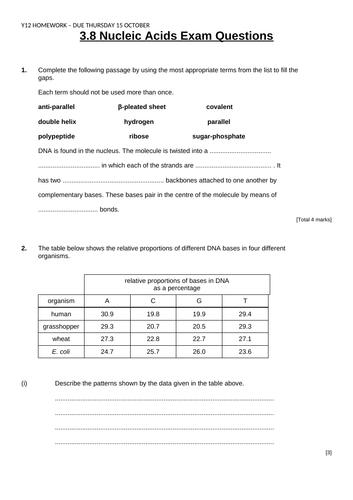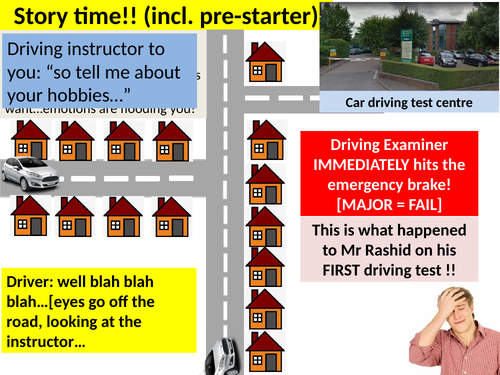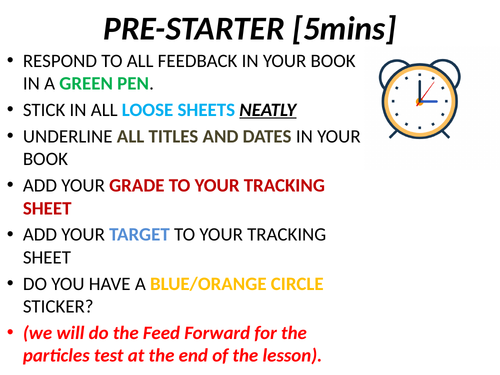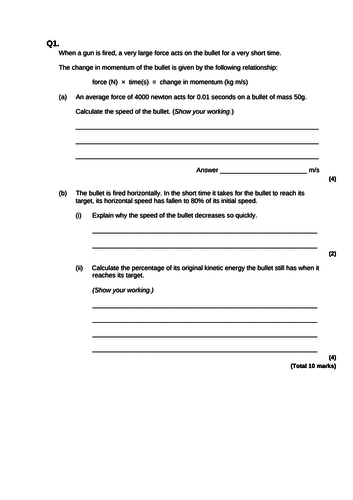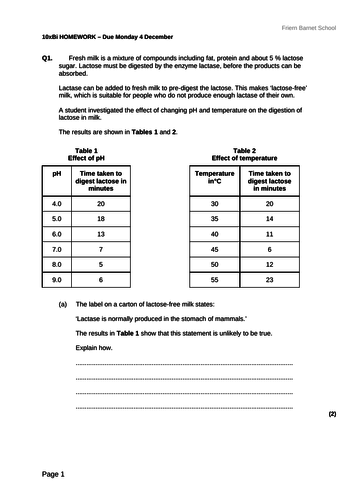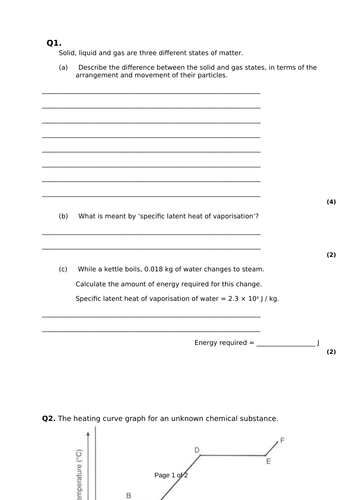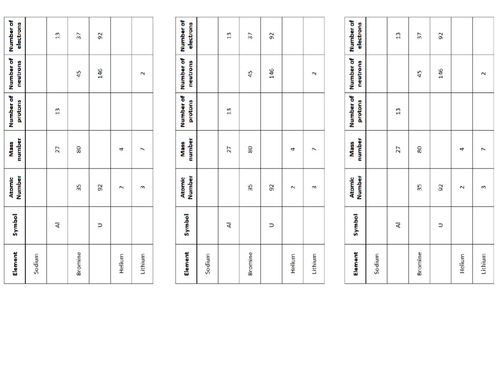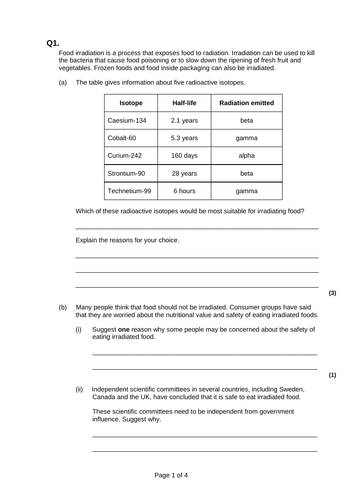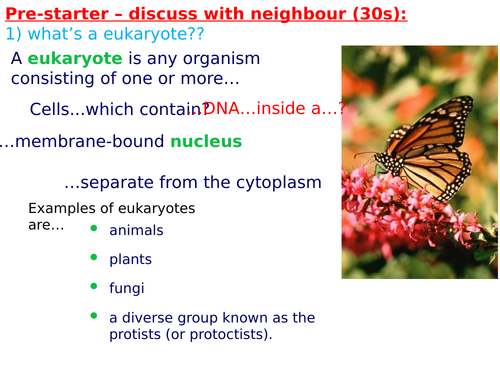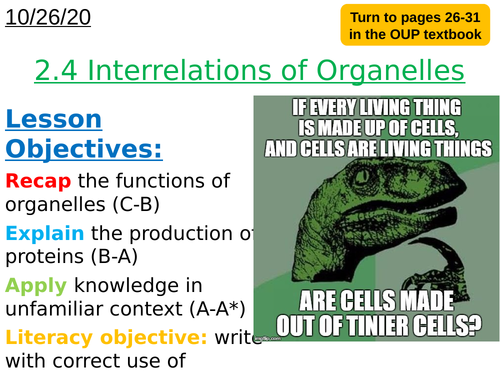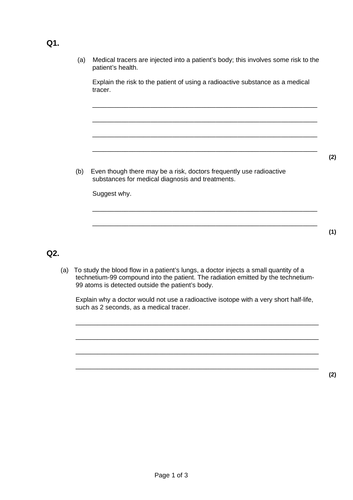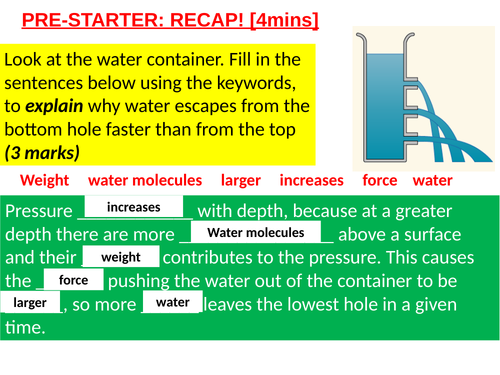172Uploads
28k+Views
2k+Downloads
Featured resources

OCR A-Level Biology (H420): Chapter 3 - Biological Molecules - L8 (part 2)
Lesson Title: Nucleic Acids (part 2)
This lesson is for teaching the above named lesson as part of the OCR specification for A-Level Biology (H420): Chapter 3 - Biological Molecules.
The lesson has the following features embedded:
Lesson has Bloom’s Taxonomy embedded throughout which are also graded for differentiation.
Stretch and challenge
AfL (progress checks embedded)
Narrative of lesson structure is clear and focused as well as engaging.
Pre-starter prepared.
The lesson is geared with top-down approach pedagogy and provide inclusive differentiation for low attaining and medium attaining pupils as well.
The lesson should be ‘tweaked’ to meet the needs of your own pupils.

AQA GCSE Physics Unit 1 (P1): Particle Model of Matter - full (Trilogy and Triple Science Lessons)
This lesson pack is for teaching the above named module Particle Model of Matter of Physics Unit 1 (P1) of the new 2018 AQA GCSE specification for GCSE Physics.
The lessons have the following features embedded:
Lesson has Bloom’s Taxonomy embedded throughout which are also graded for differentiation.
Stretch and challenge
AfL (progress checks embedded)
Narrative of lesson structure is clear and focused as well as engaging.
Pre-starter prepared.
The lesson is geared with top-down approach pedagogy and provide inclusive differentiation for low attaining and medium attaining pupils as well.
The lesson should be ‘tweaked’ to meet the needs of your own pupils.
This module pack is offered at a discount rate to buying all the module lessons individually.

AQA GCSE Physics Unit 2 (P2): Forces Module - Forces and Braking L14
This lesson is for teaching the above named lesson as part of the Forces Module of Physics Unit 2 (P2) of the new 2018 AQA GCSE specification for GCSE Physics.
The lesson has the following features embedded:
Lesson has Bloom’s Taxonomy embedded throughout which are also graded for differentiation.
Stretch and challenge
AfL (progress checks embedded)
Narrative of lesson structure is clear and focused as well as engaging.
Pre-starter prepared.
The lesson is geared with top-down approach pedagogy and provide inclusive differentiation for low attaining and medium attaining pupils as well.
The lesson should be ‘tweaked’ to meet the needs of your own pupils.

AQA GCSE Physics Unit 1 (P1): Atomic Structure - History of Atom Models L2
This lesson is for teaching the above named lesson as part of the Atomic Structure Module of Physics Unit 1 (P1) of the new 2018 AQA GCSE specification for GCSE Physics.
The lesson has the following features embedded:
Lesson has Bloom’s Taxonomy embedded throughout which are also graded for differentiation.
Stretch and challenge
AfL (progress checks embedded)
Narrative of lesson structure is clear and focused as well as engaging.
Pre-starter prepared.
The lesson is geared with top-down approach pedagogy and provide inclusive differentiation for low attaining and medium attaining pupils as well.
The lesson should be ‘tweaked’ to meet the needs of your own pupils.

2018 AQA GCSE Physics unit 1 (P1): Power and Work Done L4
This lesson is for teaching the above named lesson as part of the Energy module of Physics Unit 1 (P1) of the new 2018 AQA GCSE specifications for Combined Science: Trilogy and GCSE Physics.
The lesson has the following features embedded:
Lesson has Bloom’s Taxonomy embedded throughout which are also graded for differentiation.
Stretch and challenge tasks throughout (including Grade 8-9+ questions and extended writing)
AfL (3 progress checks embedded)
Differentiation is strong as has been noted in formal school observations for the last 2 years of teaching AQA.
Narrative of lesson structure is clear and focused as well as engaging.
Pre-starter prepared.
The lesson is geared with top-down approach pedagogy and provide inclusive differentiation for low attaining and medium attaining pupils as well.
The lesson should be ‘tweaked’ to meet the needs of your own pupils.

2018 AQA GCSE Biology Unit 2 (B2): Kidneys and Kidney Dialysis
This lesson is for teaching the above named lesson as part of the Homeostasis and Response Module of Biology Unit 2 (B2) of the new 2018 AQA GCSE specification for GCSE Biology. This pack contains two lessons to deliver content on Kidney function and Kidney disease treatment methods.
The lesson has the following features embedded:
Lesson has Bloom’s Taxonomy embedded throughout which are also graded for differentiation.
Stretch and challenge tasks throughout (including Grade 8-9+ questions and extended writing)
AfL (3 progress checks embedded)
Differentiation is strong as has been noted in formal school observations for the last 2 years of teaching AQA.
Narrative of lesson structure is clear and focused as well as engaging.
Pre-starter prepared.
The lesson is geared with top-down approach pedagogy and provide inclusive differentiation for low attaining and medium attaining pupils as well.
The lesson should be ‘tweaked’ to meet the needs of your own pupils.
NOTE: You can purchase the entire lesson pack for GCSE Biology Unit 2 and Unit 1 (or both units as a whole pack) which contains all Trilogy and Triple Science lessons at a 20% discount. Please look through the resources to find this special ongoing offer.

2018 AQA GCSE Biology Unit 1 (B1): Digestive System L10
This lesson is for teaching the above named lesson as part of the Cell Biology module of Biology Unit 1 (B1) of the new 2018 AQA GCSE specifications for Combined Science: Trilogy and GCSE Biology.
The lesson has the following features embedded:
Lesson has Bloom’s Taxonomy embedded throughout which are also graded for differentiation.
Stretch and challenge tasks throughout (including Grade 8-9+ questions and extended writing)
AfL (3 progress checks embedded)
Differentiation is strong as has been noted in all formal school observations for the last 2 years of teaching AQA.
Narrative of lesson structure is clear and focused as well as engaging.
Pre-starter prepared.
The lesson is geared with top-down approach pedagogy and provide inclusive differentiation for low attaining and medium attaining pupils as well.
The lesson should be ‘tweaked’ to meet the needs of your own pupils.

AQA GCSE Physics Unit 1 (P1): Energy Module - Infrared Radiation/Black Body Radiation L5
This lesson is for teaching the above named lesson as part of the Energy Module of Physics Unit 1 (P1) of the new 2018 AQA GCSE specification for GCSE Physics.
The lesson has the following features embedded:
Lesson has Bloom’s Taxonomy embedded throughout which are also graded for differentiation.
Stretch and challenge
AfL (progress checks embedded)
Narrative of lesson structure is clear and focused as well as engaging.
Pre-starter prepared.
The lesson is geared with top-down approach pedagogy and provide inclusive differentiation for low attaining and medium attaining pupils as well.
The lesson should be ‘tweaked’ to meet the needs of your own pupils.

AQA GCSE Physics Unit 1 (P1): Particle Model of Matter Module - Specific Latent Heat L2
This lesson is for teaching the above named lesson as part of the Particle Model of Matter Module of Physics Unit 1 (P1) of the new 2018 AQA GCSE specification for GCSE Physics.
The lesson has the following features embedded:
Lesson has Bloom’s Taxonomy embedded throughout which are also graded for differentiation.
Stretch and challenge
AfL (progress checks embedded)
Narrative of lesson structure is clear and focused as well as engaging.
Pre-starter prepared.
The lesson is geared with top-down approach pedagogy and provide inclusive differentiation for low attaining and medium attaining pupils as well.
The lesson should be ‘tweaked’ to meet the needs of your own pupils.

AQA GCSE Physics Unit 1 (P1): Particle Model of Matter - Density Required Practical L5
This lesson is for teaching the above named lesson as part of the Particle Model of Matter Module of Physics Unit 1 (P1) of the new 2018 AQA GCSE specification for GCSE Physics.
The lesson has the following features embedded:
Lesson has Bloom’s Taxonomy embedded throughout which are also graded for differentiation.
Stretch and challenge
AfL (progress checks embedded)
Narrative of lesson structure is clear and focused as well as engaging.
Pre-starter prepared.
The lesson is geared with top-down approach pedagogy and provide inclusive differentiation for low attaining and medium attaining pupils as well.
The lesson should be ‘tweaked’ to meet the needs of your own pupils.

AQA GCSE Physics Unit 1 (P1): Atomic Structure - Mass number and isotopes L1
This lesson is for teaching the above named lesson as part of the Atomic Structure Module of Physics Unit 1 (P1) of the new 2018 AQA GCSE specification for GCSE Physics.
The lesson has the following features embedded:
Lesson has Bloom’s Taxonomy embedded throughout which are also graded for differentiation.
Stretch and challenge
AfL (progress checks embedded)
Narrative of lesson structure is clear and focused as well as engaging.
Pre-starter prepared.
The lesson is geared with top-down approach pedagogy and provide inclusive differentiation for low attaining and medium attaining pupils as well.
The lesson should be ‘tweaked’ to meet the needs of your own pupils.

AQA GCSE Physics Unit 1 (P1): Atomic Structure - Half-lives and radioactive contamination. L5
This lesson is for teaching the above named lesson as part of the Atomic Structure Module of Physics Unit 1 (P1) of the new 2018 AQA GCSE specification for GCSE Physics.
The lesson has the following features embedded:
Lesson has Bloom’s Taxonomy embedded throughout which are also graded for differentiation.
Stretch and challenge
AfL (progress checks embedded)
Narrative of lesson structure is clear and focused as well as engaging.
Pre-starter prepared.
The lesson is geared with top-down approach pedagogy and provide inclusive differentiation for low attaining and medium attaining pupils as well.
The lesson should be ‘tweaked’ to meet the needs of your own pupils.

OCR A-Level Biology (H420): Chapter 2 - Basic Components of Living Systems - L6
Lesson Title: Eukaryotic Cell Structure (Lesson 1)
This lesson is for teaching the above named lesson as part of the OCR specification for A-Level Biology (H420): Chapter 2 - Basic Components of Living Systems.
The lesson has the following features embedded:
Lesson has Bloom’s Taxonomy embedded throughout which are also graded for differentiation.
Stretch and challenge
AfL (progress checks embedded)
Narrative of lesson structure is clear and focused as well as engaging.
Pre-starter prepared.
The lesson is geared with top-down approach pedagogy and provide inclusive differentiation for low attaining and medium attaining pupils as well.
The lesson should be ‘tweaked’ to meet the needs of your own pupils.

OCR A-Level Biology (H420): Chapter 2 - Basic Components of Living Systems - L7
Lesson Title: Eukaryotic Cell Structure - Interrelations of Organelles (Lesson 2)
This lesson is for teaching the above named lesson as part of the OCR specification for A-Level Biology (H420): Chapter 2 - Basic Components of Living Systems.
The lesson has the following features embedded:
Lesson has Bloom’s Taxonomy embedded throughout which are also graded for differentiation.
Stretch and challenge
AfL (progress checks embedded)
Narrative of lesson structure is clear and focused as well as engaging.
Pre-starter prepared.
The lesson is geared with top-down approach pedagogy and provide inclusive differentiation for low attaining and medium attaining pupils as well.
The lesson should be ‘tweaked’ to meet the needs of your own pupils.

AQA GCSE Physics Unit 1 (P1): Atomic Structure - Nuclear Radiation in Medicine L6
This lesson is for teaching the above named lesson as part of the Atomic Structure Module of Physics Unit 1 (P1) of the new 2018 AQA GCSE specification for GCSE Physics.
The lesson has the following features embedded:
Lesson has Bloom’s Taxonomy embedded throughout which are also graded for differentiation.
Stretch and challenge
AfL (progress checks embedded)
Narrative of lesson structure is clear and focused as well as engaging.
Pre-starter prepared.
The lesson is geared with top-down approach pedagogy and provide inclusive differentiation for low attaining and medium attaining pupils as well.
The lesson should be ‘tweaked’ to meet the needs of your own pupils.

OCR A-Level Biology (H420): Chapter 3 - Biological Molecules - L9
Lesson Title: DNA Replication and the Genetic Code
This lesson is for teaching the above named lesson as part of the OCR specification for A-Level Biology (H420): Chapter 3 - Biological Molecules.
The lesson has the following features embedded:
Lesson has Bloom’s Taxonomy embedded throughout which are also graded for differentiation.
Stretch and challenge
AfL (progress checks embedded)
Narrative of lesson structure is clear and focused as well as engaging.
Pre-starter prepared.
The lesson is geared with top-down approach pedagogy and provide inclusive differentiation for low attaining and medium attaining pupils as well.
The lesson should be ‘tweaked’ to meet the needs of your own pupils.

AQA GCSE Physics Unit 2 (P2): Forces Module - Atmospheric Pressure L11
This lesson is for teaching the above named lesson as part of the Forces Module of Physics Unit 2 (P2) of the new 2018 AQA GCSE specification for GCSE Physics.
The lesson has the following features embedded:
Lesson has Bloom’s Taxonomy embedded throughout which are also graded for differentiation.
Stretch and challenge
AfL (progress checks embedded)
Narrative of lesson structure is clear and focused as well as engaging.
Pre-starter prepared.
The lesson is geared with top-down approach pedagogy and provide inclusive differentiation for low attaining and medium attaining pupils as well.
The lesson should be ‘tweaked’ to meet the needs of your own pupils.

AQA GCSE Physics Unit 1 (P1): Electricity Module - Series and Parallel Circuits L1
This lesson is for teaching the above named lesson as part of the Electricity Module of Physics Unit 1 (P1) of the new 2018 AQA GCSE specification for GCSE Physics.
The lesson has the following features embedded:
Lesson has Bloom’s Taxonomy embedded throughout which are also graded for differentiation.
Stretch and challenge
AfL (progress checks embedded)
Narrative of lesson structure is clear and focused as well as engaging.
Pre-starter prepared.
The lesson is geared with top-down approach pedagogy and provide inclusive differentiation for low attaining and medium attaining pupils as well.
The lesson should be ‘tweaked’ to meet the needs of your own pupils.

AQA GCSE Physics Unit 1 (P1): Electricity Module - Static Electricity
This lesson is for teaching the above named lesson as part of the Electricity Module of Physics Unit 1 (P1) of the new 2018 AQA GCSE specification for GCSE Physics.
The lesson has the following features embedded:
Lesson has Bloom’s Taxonomy embedded throughout which are also graded for differentiation.
Stretch and challenge
AfL (progress checks embedded)
Narrative of lesson structure is clear and focused as well as engaging.
Pre-starter prepared.
The lesson is geared with top-down approach pedagogy and provide inclusive differentiation for low attaining and medium attaining pupils as well.
The lesson should be ‘tweaked’ to meet the needs of your own pupils.

2018 AQA GCSE Biology Unit 1 (B1): Blood Vessels L14
This lesson is for teaching the above named lesson as part of the Organisation module of Biology Unit 1 (B1) of the new 2018 AQA GCSE specifications for Combined Science: Trilogy and GCSE Biology.
The lesson has the following features embedded:
Lesson has Bloom’s Taxonomy embedded throughout which are also graded for differentiation.
Stretch and challenge tasks throughout (including Grade 8-9+ questions and extended writing)
AfL (3 progress checks embedded)
Differentiation is strong as has been noted in all formal school observations for the last 2 years of teaching AQA.
Narrative of lesson structure is clear and focused as well as engaging.
Pre-starter prepared.
The lesson is geared with top-down approach pedagogy and provide inclusive differentiation for low attaining and medium attaining pupils as well.
The lesson should be ‘tweaked’ to meet the needs of your own pupils.


